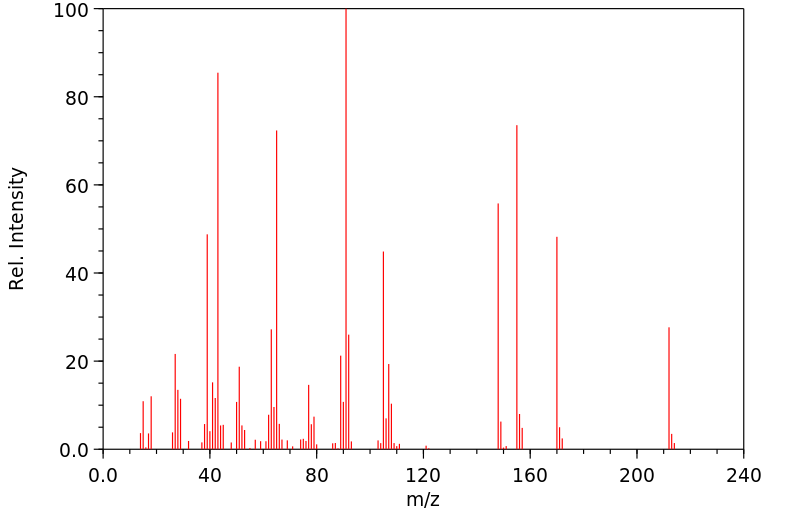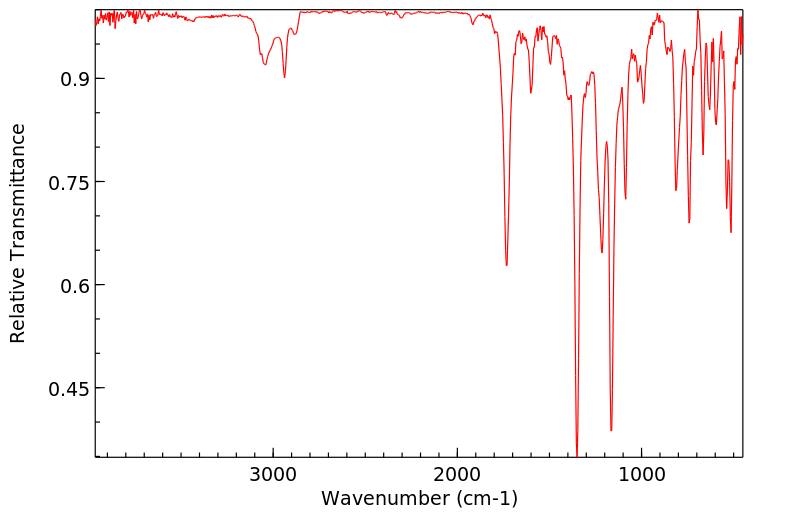4-甲苯磺酰丙酮 | 5366-49-4
中文名称
4-甲苯磺酰丙酮
中文别名
对甲苯磺酰丙酮
英文名称
4-toluenesulfonylacetone
英文别名
1-tosylpropan-2-one;tosylacetone;1-(p-toluenesulfonyl)-propan-2-one;1-(4-methylphenylsulfonyl)propan-2-one;(p-tolylsulfonyl)acetone;1-(4-methylphenyl)sulfonylpropan-2-one
CAS
5366-49-4
化学式
C10H12O3S
mdl
MFCD00026240
分子量
212.269
InChiKey
NDQXJNHOGLQSMB-UHFFFAOYSA-N
BEILSTEIN
——
EINECS
——
-
物化性质
-
计算性质
-
ADMET
-
安全信息
-
SDS
-
制备方法与用途
-
上下游信息
-
文献信息
-
表征谱图
-
同类化合物
-
相关功能分类
-
相关结构分类
物化性质
-
熔点:52 °C
-
沸点:167 °C(Press: 0.1 Torr)
-
密度:1.195±0.06 g/cm3(Predicted)
-
稳定性/保质期:
在常温常压下保持稳定
计算性质
-
辛醇/水分配系数(LogP):1.3
-
重原子数:14
-
可旋转键数:3
-
环数:1.0
-
sp3杂化的碳原子比例:0.3
-
拓扑面积:59.6
-
氢给体数:0
-
氢受体数:3
安全信息
-
危险等级:IRRITANT
-
安全说明:S26,S36/37/39
-
危险类别码:R36/37/38
-
海关编码:2914399090
-
危险性防范说明:P261,P301+P312,P302+P352,P304+P340,P305+P351+P338
-
危险性描述:H302,H315,H319,H335
-
储存条件:请将药品存放在避光、阴凉干燥的地方,并密封保存。
SDS
SECTION 1: Identification of the substance/mixture and of the company/undertaking
Product identifiers
Product name : 1-(P-Tolylsulfonyl)-2-Propanone
REACH No. : A registration number is not available for this substance as the substance
or its uses are exempted from registration, the annual tonnage does not
require a registration or the registration is envisaged for a later
registration deadline.
Relevant identified uses of the substance or mixture and uses advised against
Identified uses : Laboratory chemicals, Manufacture of substances
SECTION 2: Hazards identification
Classification of the substance or mixture
Not a hazardous substance or mixture according to Regulation (EC) No. 1272/2008.
This substance is not classified as dangerous according to Directive 67/548/EEC.
Label elements
The product does not need to be labelled in accordance with EC directives or respective national laws.
Other hazards
This substance/mixture contains no components considered to be either persistent, bioaccumulative and
toxic (PBT), or very persistent and very bioaccumulative (vPvB) at levels of 0.1% or higher.
SECTION 3: Composition/information on ingredients
Substances
Molecular weight : 212,27 g/mol
No components need to be disclosed according to the applicable regulations.
SECTION 4: First aid measures
Description of first aid measures
If inhaled
If breathed in, move person into fresh air. If not breathing, give artificial respiration.
In case of skin contact
Wash off with soap and plenty of water.
In case of eye contact
Flush eyes with water as a precaution.
If swallowed
Never give anything by mouth to an unconscious person. Rinse mouth with water.
Most important symptoms and effects, both acute and delayed
The most important known symptoms and effects are described in the labelling (see section 2.2) and/or in
section 11
Indication of any immediate medical attention and special treatment needed
No data available
SECTION 5: Firefighting measures
Extinguishing media
Suitable extinguishing media
Use water spray, alcohol-resistant foam, dry chemical or carbon dioxide.
Special hazards arising from the substance or mixture
Nature of decomposition products not known.
Advice for firefighters
Wear self-contained breathing apparatus for firefighting if necessary.
Further information
No data available
SECTION 6: Accidental release measures
Personal precautions, protective equipment and emergency procedures
Avoid dust formation. Avoid breathing vapours, mist or gas.
For personal protection see section 8.
Environmental precautions
No special environmental precautions required.
Methods and materials for containment and cleaning up
Sweep up and shovel. Keep in suitable, closed containers for disposal.
Reference to other sections
For disposal see section 13.
SECTION 7: Handling and storage
Precautions for safe handling
Provide appropriate exhaust ventilation at places where dust is formed.
For precautions see section 2.2.
Conditions for safe storage, including any incompatibilities
Store in cool place. Keep container tightly closed in a dry and well-ventilated place.
Storage class (TRGS 510): Non Combustible Solids
Specific end use(s)
Apart from the uses mentioned in section 1.2 no other specific uses are stipulated
SECTION 8: Exposure controls/personal protection
Control parameters
Components with workplace control parameters
Exposure controls
Appropriate engineering controls
General industrial hygiene practice.
Personal protective equipment
Eye/face protection
Use equipment for eye protection tested and approved under appropriate government standards
such as NIOSH (US) or EN 166(EU).
Skin protection
Handle with gloves. Gloves must be inspected prior to use. Use proper glove removal technique
(without touching glove's outer surface) to avoid skin contact with this product. Dispose of
contaminated gloves after use in accordance with applicable laws and good laboratory practices.
Wash and dry hands.
The selected protective gloves have to satisfy the specifications of EU Directive 89/686/EEC and
the standard EN 374 derived from it.
Body Protection
Choose body protection in relation to its type, to the concentration and amount of dangerous
substances, and to the specific work-place., The type of protective equipment must be selected
according to the concentration and amount of the dangerous substance at the specific workplace.
Respiratory protection
Respiratory protection is not required. Where protection from nuisance levels of dusts are desired,
use type N95 (US) or type P1 (EN 143) dust masks. Use respirators and components tested and
approved under appropriate government standards such as NIOSH (US) or CEN (EU).
Control of environmental exposure
No special environmental precautions required.
SECTION 9: Physical and chemical properties
Information on basic physical and chemical properties
a) Appearance Form: solid
b) Odour No data available
c) Odour Threshold No data available
d) pH No data available
e) Melting point/freezing No data available
point
f) Initial boiling point and No data available
boiling range
g) Flash point No data available
h) Evaporation rate No data available
i) Flammability (solid, gas) No data available
j) Upper/lower No data available
flammability or
explosive limits
k) Vapour pressure No data available
l) Vapour density No data available
m) Relative density No data available
n) Water solubility No data available
o) Partition coefficient: n- No data available
octanol/water
p) Auto-ignition No data available
temperature
q) Decomposition No data available
temperature
r) Viscosity No data available
s) Explosive properties No data available
t) Oxidizing properties No data available
Other safety information
No data available
SECTION 10: Stability and reactivity
Reactivity
No data available
Chemical stability
Stable under recommended storage conditions.
Possibility of hazardous reactions
No data available
Conditions to avoid
No data available
Incompatible materials
No data available
Hazardous decomposition products
In the event of fire: see section 5
SECTION 11: Toxicological information
Information on toxicological effects
Acute toxicity
No data available
Skin corrosion/irritation
No data available
Serious eye damage/eye irritation
No data available
Respiratory or skin sensitisation
No data available
Germ cell mutagenicity
No data available
Carcinogenicity
IARC: No component of this product present at levels greater than or equal to 0.1% is identified as
probable, possible or confirmed human carcinogen by IARC.
Reproductive toxicity
No data available
Specific target organ toxicity - single exposure
No data available
Specific target organ toxicity - repeated exposure
No data available
Aspiration hazard
No data available
Additional Information
RTECS: Not available
SECTION 12: Ecological information
Toxicity
No data available
Persistence and degradability
No data available
Bioaccumulative potential
No data available
Mobility in soil
No data available
Results of PBT and vPvB assessment
This substance/mixture contains no components considered to be either persistent, bioaccumulative and
toxic (PBT), or very persistent and very bioaccumulative (vPvB) at levels of 0.1% or higher.
Other adverse effects
No data available
SECTION 13: Disposal considerations
Waste treatment methods
Product
Offer surplus and non-recyclable solutions to a licensed disposal company.
Contaminated packaging
Dispose of as unused product.
SECTION 14: Transport information
UN number
ADR/RID: - IMDG: - IATA: -
UN proper shipping name
ADR/RID: Not dangerous goods
IMDG: Not dangerous goods
IATA: Not dangerous goods
Transport hazard class(es)
ADR/RID: - IMDG: - IATA: -
Packaging group
ADR/RID: - IMDG: - IATA: -
Environmental hazards
ADR/RID: no IMDG Marine pollutant: no IATA: no
Special precautions for user
No data available
SECTION 15: Regulatory information
This safety datasheet complies with the requirements of Regulation (EC) No. 1907/2006.
Safety, health and environmental regulations/legislation specific for the substance or mixture
No data available
Chemical Safety Assessment
For this product a chemical safety assessment was not carried out
SECTION 16: Other information
Further information
Copyright 2014 Co. LLC. License granted to make unlimited paper copies for internal use
only.
The above information is believed to be correct but does not purport to be all inclusive and shall be
used only as a guide. The information in this document is based on the present state of our knowledge
and is applicable to the product with regard to appropriate safety precautions. It does not represent any
guarantee of the properties of the product. Corporation and its Affiliates shall not be held
liable for any damage resulting from handling or from contact with the above product. See
and/or the reverse side of invoice or packing slip for additional terms and conditions of sale.
上下游信息
-
上游原料
中文名称 英文名称 CAS号 化学式 分子量 —— 1-(4-methylphenylsulfonyl)propan-2-ol 85870-05-9 C10H14O3S 214.285 1-甲基-4-(2-丙炔磺酰基)-苯 4-tosylacetonitrile 16192-07-7 C10H10O2S 194.254 (4-甲基苯基硫)丙酮 1-(p-tolylsulfanyl)propan-2-one 1200-13-1 C10H12OS 180.271 —— 4-methylphenyl prop-1-enyl sulfone 32228-15-2 C10H12O2S 196.27 —— p-tolylsulfonylallene 16192-08-8 C10H10O2S 194.254 —— 1-(p-toluenesulfonyl)propyne 14027-53-3 C10H10O2S 194.254 -
下游产品
中文名称 英文名称 CAS号 化学式 分子量 3-氯-1-((4-甲基苯基)磺酰基)乙酮 3-chloro-1-((4-methylphenyl)sulfonyl)acetone 57122-47-1 C10H11ClO3S 246.715 —— 1-bromo-3-(toluene-4-sulfonyl)-acetone 874009-26-4 C10H11BrO3S 291.166 —— 1,3-bis-(toluene-4-sulfonyl)-acetone 39180-21-7 C17H18O5S2 366.459 1-甲基-4-(丙基磺酰基)苯 1-(4-tolylsulfonyl)propane 90926-25-3 C10H14O2S 198.286 —— 1-chloro-1-p.toluenesulphonylacetone 101246-34-8 C10H11ClO3S 246.715 —— (S)-1-(4-methylphenylsulfonyl)propan-2-ol 109610-75-5 C10H14O3S 214.285 —— 1-tosylpropan-2-ol —— C10H14O3S 214.285 —— 1-(4-methylphenylsulfonyl)propan-2-ol 85870-05-9 C10H14O3S 214.285 —— 3-(4-Methylbenzene-1-sulfonyl)hex-5-en-2-one 67605-00-9 C13H16O3S 252.334 —— 1-diazo-1-tosylpropan-2-one 2725-60-2 C10H10N2O3S 238.267 对甲砜基甲苯 Methyl p-tolyl sulfone 3185-99-7 C8H10O2S 170.232 —— 5-Methyl-3-tosyl-hex-5-en-2-one 118068-97-6 C14H18O3S 266.361 —— 1-(cinnamylsulfonyl)-4-methylbenzene 20605-48-5 C16H16O2S 272.368 对甲苯磺酰氯甲烷 chloromethyl p-tolylsulfone 7569-26-8 C8H9ClO2S 204.677 1-(溴甲基磺酰基)-4-甲基苯 bromomethyl 4-tolyl sulfone 37891-95-5 C8H9BrO2S 249.128 —— 1-((iodom ethyl)sulfonyl)-4-methylbenzene 37891-96-6 C8H9IO2S 296.129 1-甲基-2-[(4-甲基苯基)磺酰基甲基]吡咯烷 4-methylphenyl (1-methylpyrrolidin-2-yl)methyl sulfone 826994-67-6 C13H19NO2S 253.365 —— 1-methyl-4-[(2-methylprop-1-en-1-yl)sulfonyl]benzene 16192-03-3 C11H14O2S 210.297 —— p-tosyldiazomethane 1538-98-3 C8H8N2O2S 196.23 甲巯基甲基对甲苯砜 methylthiomethyl p-tolyl sulfone 59662-65-6 C9H12O2S2 216.325 - 1
- 2
反应信息
-
作为反应物:描述:4-甲苯磺酰丙酮 在 双氧水 、 碘 、 palladium diacetate 、 caesium carbonate 、 溶剂黄146 、 4,5-双二苯基膦-9,9-二甲基氧杂蒽 、 sodium hydroxide 作用下, 以 水 、 苯 为溶剂, 反应 15.0h, 生成 1-(cinnamylsulfonyl)-4-methylbenzene参考文献:名称:官能化烷基卤化物与乙烯基芳烃/杂芳烃的可见光诱导室温 Heck 反应摘要:第一个可见光诱导的 Pd 催化的 α-杂原子取代的烷基碘化物和-溴化物与乙烯基芳烃/杂芳烃的 Heck 反应已经开发出来。这种转化在室温下有效进行,并能够从相应的α-取代甲基碘合成有价值的官能化烯丙基系统,例如烯丙基硅烷、硼酸酯、锗烷、锡烷、新戊酸酯、膦酸酯、邻苯二甲酰亚胺和甲苯磺酸酯。值得注意的是,后一种底物的合成在现有的热诱导钯催化条件下失败,这凸显了可见光对于这种转变的重要性。DOI:10.1002/anie.201706554
-
作为产物:参考文献:名称:在布朗斯台德酸中由(芳磺酰基)-和(芳基亚磺酰基)亚芳基生成1,2-氧杂硫鎓离子。NMR和DFT研究这些阳离子及其反应。摘要:在强布朗斯台德酸(CF3SO3H,FSO3H,D2SO4)中,(芳磺酰基)烯(ArSO2-CR1 = C = CR2R3)和(芳亚磺酰基)烯(ArSO-CR1 = C = CR2R3)环化成相应的稳定的1,2-氧杂硫鎓离子,通过NMR和DFT计算进行了研究。用低亲核介质(HCl水溶液)淬灭这些阳离子的溶液会导致它们的去质子化,并形成立体选择性的(芳磺酰基)丁二烯(例如,ArSO2-CR1 = CC(Me)= CH2,对于R2 = R3 = Me,收率的87-98%)。TfOH(0.1当量)-HFIP(六氟丙烷-2-醇)体系中的(芳磺酰基)丙二烯反应后水解生成烯丙醇(ArSO2-CR1 = CH-C(OH)R2R3,收率78-99% )。在(1当量)TfOH(1当量)存在下,(芳磺酰基)丙二烯溶液的回流导致环化成硫代色素1,1-二氧化物产量高。在TfOH或AlX 3(X = Cl,Br)的作DOI:10.3762/bjoc.14.268
文献信息
-
Allylation of Active Methylene Compounds with Allyl Oxime Carbonates Catalyzed by Pd(0)作者:Osamu Suzuki、Yoshiharu Hashiguchi、Seiichi Inoue、Kikumasa SatoDOI:10.1246/cl.1988.291日期:1988.2.5Allylation of active methylene compounds catalyzed by a palladium(0)-phosphine system took place highly stereoselectively by employing allyl oxime carbonates as the allylating reagent.
-
α-Diazosulphones and related compounds from the base-induced cleavage of α-diazo-β-ketosulphones作者:D. Hodson、G. Holt、D. K. WallDOI:10.1039/j39680002201日期:——sulphonylformaldehyde hydrazones (70—80%), a previously unknown class of compounds, which arose by hydrolysis of the first formed phosphazine. The acylsulphonyldiazomethanes were prepared by the action of toluene-p-sulphonyl azide and triethylamine on β-ketosulphones in 60% aqueous ethanol. If the diazoketosulphone is retained in solution and the reaction period prolonged, sulphonylformaldehyde hydrazones may be
-
<i>p</i>-Toluenesulfonic Acid Promoted Annulation of 2-Alkynylanilines with Activated Ketones: Efficient Synthesis of 4-Alkyl-2,3-Disubstituted Quinolines作者:Changlan Peng、Yong Wang、Lanying Liu、Honggen Wang、Jiaji Zhao、Qiang ZhuDOI:10.1002/ejoc.200901257日期:2010.2Reactions between readily available 2-alkynylanilines and activated ketones such as β-keto esters promoted by p-toluenesulfonic acid afford 4-alkyl-2,3-disubstituted quinolines in good to excellent yields. The generality of substituents at the other end of the triple bond of 2-alkynylanilines makes the method a valuable approach to diversified 4-alkylquin-olines, which are difficult to obtain by classical
-
Rh(III)-Catalyzed Redox-Neutral Annulation of Primary Benzamides with Diazo Compounds: Approach to Isoquinolinones作者:Youzhi Wu、Peng Sun、Kaifan Zhang、Tie Yang、Hequan Yao、Aijun LinDOI:10.1021/acs.joc.5b02824日期:2016.3.4Reported herein is a Rh-catalyzed redox-neutral annulation of primary benzamides with diazo compounds, representing an efficient and economic protocol to isoquinolinones. The procedure exhibited good functional group tolerability, scalability, and regioselectivity, obviating the need for oxidants, and only environmentally benign N2 and H2O were released. Further utilization of the method provided an
-
(Arylsulfonyl)acetones and -acetonitriles: New Activated Methylenic Building Blocks for Synthesis of 1,2,3-Triazoles作者:Nazariy Pokhodylo、Vasyl Matiychuk、Mykola ObushakDOI:10.1055/s-0029-1216850日期:2009.7for 1,2,3-triazole synthesis in the Dimroth cyclization. It was shown, that sulfone reagents undergo base-catalyzed cyclization under mild conditions (at room temperature) to give 1,2,3-triazoles in moderate to excellent yields. This fact has confirmed the high nucleophilicity of sulfonylmethylenic compounds and allows new synthetic applications. azides - triazoles - sulfones - Dimroth reaction
表征谱图
-
氢谱1HNMR
-
质谱MS
-
碳谱13CNMR
-
红外IR
-
拉曼Raman
-
峰位数据
-
峰位匹配
-
表征信息
同类化合物
(βS)-β-氨基-4-(4-羟基苯氧基)-3,5-二碘苯甲丙醇
(S,S)-邻甲苯基-DIPAMP
(S)-(-)-7'-〔4(S)-(苄基)恶唑-2-基]-7-二(3,5-二-叔丁基苯基)膦基-2,2',3,3'-四氢-1,1-螺二氢茚
(S)-盐酸沙丁胺醇
(S)-3-(叔丁基)-4-(2,6-二甲氧基苯基)-2,3-二氢苯并[d][1,3]氧磷杂环戊二烯
(S)-2,2'-双[双(3,5-三氟甲基苯基)膦基]-4,4',6,6'-四甲氧基联苯
(S)-1-[3,5-双(三氟甲基)苯基]-3-[1-(二甲基氨基)-3-甲基丁烷-2-基]硫脲
(R)富马酸托特罗定
(R)-(-)-盐酸尼古地平
(R)-(-)-4,12-双(二苯基膦基)[2.2]对环芳烷(1,5环辛二烯)铑(I)四氟硼酸盐
(R)-(+)-7-双(3,5-二叔丁基苯基)膦基7''-[((6-甲基吡啶-2-基甲基)氨基]-2,2'',3,3''-四氢-1,1''-螺双茚满
(R)-(+)-7-双(3,5-二叔丁基苯基)膦基7''-[(4-叔丁基吡啶-2-基甲基)氨基]-2,2'',3,3''-四氢-1,1''-螺双茚满
(R)-(+)-7-双(3,5-二叔丁基苯基)膦基7''-[(3-甲基吡啶-2-基甲基)氨基]-2,2'',3,3''-四氢-1,1''-螺双茚满
(R)-(+)-4,7-双(3,5-二-叔丁基苯基)膦基-7“-[(吡啶-2-基甲基)氨基]-2,2”,3,3'-四氢1,1'-螺二茚满
(R)-3-(叔丁基)-4-(2,6-二苯氧基苯基)-2,3-二氢苯并[d][1,3]氧杂磷杂环戊烯
(R)-2-[((二苯基膦基)甲基]吡咯烷
(R)-1-[3,5-双(三氟甲基)苯基]-3-[1-(二甲基氨基)-3-甲基丁烷-2-基]硫脲
(N-(4-甲氧基苯基)-N-甲基-3-(1-哌啶基)丙-2-烯酰胺)
(5-溴-2-羟基苯基)-4-氯苯甲酮
(5-溴-2-氯苯基)(4-羟基苯基)甲酮
(5-氧代-3-苯基-2,5-二氢-1,2,3,4-oxatriazol-3-鎓)
(4S,5R)-4-甲基-5-苯基-1,2,3-氧代噻唑烷-2,2-二氧化物-3-羧酸叔丁酯
(4S,4''S)-2,2''-亚环戊基双[4,5-二氢-4-(苯甲基)恶唑]
(4-溴苯基)-[2-氟-4-[6-[甲基(丙-2-烯基)氨基]己氧基]苯基]甲酮
(4-丁氧基苯甲基)三苯基溴化磷
(3aR,8aR)-(-)-4,4,8,8-四(3,5-二甲基苯基)四氢-2,2-二甲基-6-苯基-1,3-二氧戊环[4,5-e]二恶唑磷
(3aR,6aS)-5-氧代六氢环戊基[c]吡咯-2(1H)-羧酸酯
(2Z)-3-[[(4-氯苯基)氨基]-2-氰基丙烯酸乙酯
(2S,3S,5S)-5-(叔丁氧基甲酰氨基)-2-(N-5-噻唑基-甲氧羰基)氨基-1,6-二苯基-3-羟基己烷
(2S,2''S,3S,3''S)-3,3''-二叔丁基-4,4''-双(2,6-二甲氧基苯基)-2,2'',3,3''-四氢-2,2''-联苯并[d][1,3]氧杂磷杂戊环
(2S)-(-)-2-{[[[[3,5-双(氟代甲基)苯基]氨基]硫代甲基]氨基}-N-(二苯基甲基)-N,3,3-三甲基丁酰胺
(2S)-2-[[[[[((1S,2S)-2-氨基环己基]氨基]硫代甲基]氨基]-N-(二苯甲基)-N,3,3-三甲基丁酰胺
(2S)-2-[[[[[[((1R,2R)-2-氨基环己基]氨基]硫代甲基]氨基]-N-(二苯甲基)-N,3,3-三甲基丁酰胺
(2-硝基苯基)磷酸三酰胺
(2,6-二氯苯基)乙酰氯
(2,3-二甲氧基-5-甲基苯基)硼酸
(1S,2S,3S,5S)-5-叠氮基-3-(苯基甲氧基)-2-[(苯基甲氧基)甲基]环戊醇
(1S,2S,3R,5R)-2-(苄氧基)甲基-6-氧杂双环[3.1.0]己-3-醇
(1-(4-氟苯基)环丙基)甲胺盐酸盐
(1-(3-溴苯基)环丁基)甲胺盐酸盐
(1-(2-氯苯基)环丁基)甲胺盐酸盐
(1-(2-氟苯基)环丙基)甲胺盐酸盐
(1-(2,6-二氟苯基)环丙基)甲胺盐酸盐
(-)-去甲基西布曲明
龙蒿油
龙胆酸钠
龙胆酸叔丁酯
龙胆酸
龙胆紫-d6
龙胆紫








